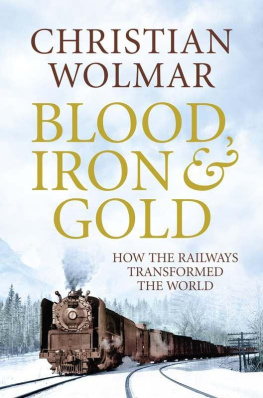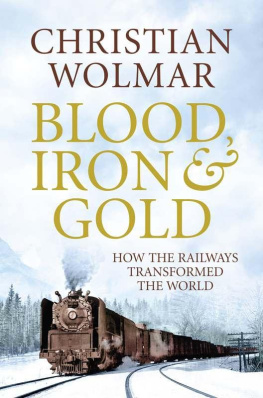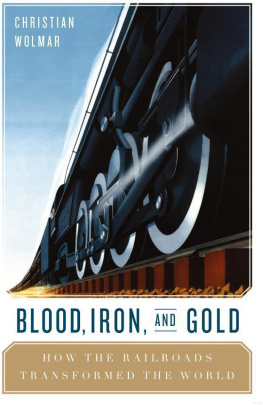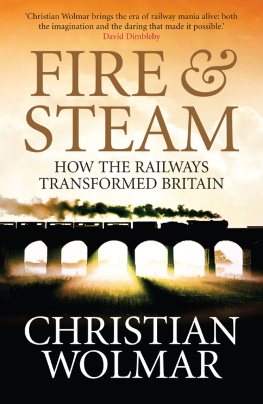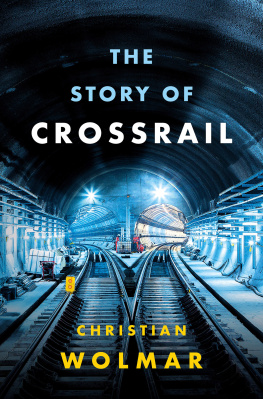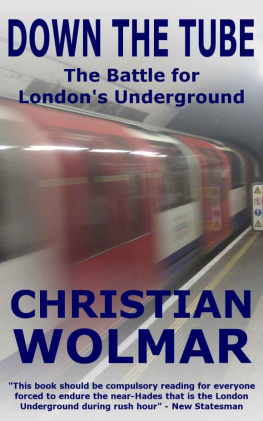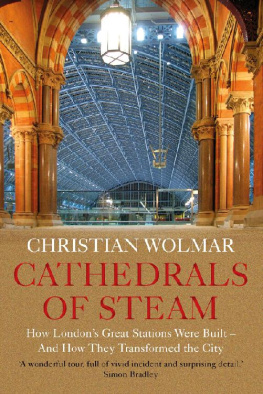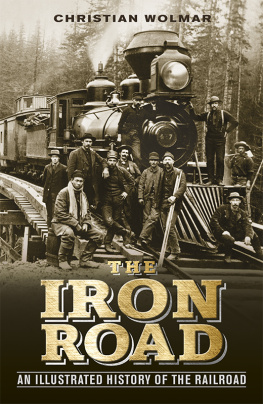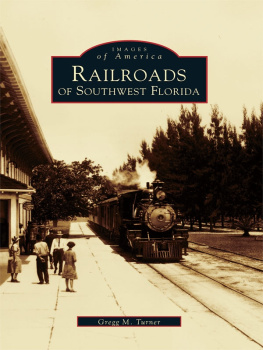First published in Great Britain in hardback in 2009 by Atlantic Books, an imprint of Grove Atlantic Ltd.
Copyright Christian Wolmar 2009
The moral right of Christian Wolmar to be identified as the author of this work has been asserted in accordance with the Copyright, Designs and Patents Act of 1988.
All rights reserved. No part of this publication may be reproduced, stored in a retrieval system or transmitted in any form or by any means, electronic, mechanical, photocopying, recording or otherwise, without the prior permission of both the copyright owner and the above publisher of this book.
Every effort has been made to trace or contact all copyright holders. The publishers will be pleased to make good any omissions or rectify any mistakes brought to their attention at the earliest opportunity.
Atlantic Books
An imprint of Grove Atlantic Ltd
Ormond House
2627 Boswell Street
London
WC1N 3JZ
www.atlantic-books.co.uk
First eBook Edition: November 2009
ISBN: 978-1-848-87434-3
Also by Christian Wolmar
Fire & Steam
The Subterranean Railway
On the Wrong Line
Down the Tube
Broken Rails
Forgotten Children
Stagecoach
The Great Railway Disaster
Dedicated to my wonderful Deborah who puts up
with my obsessions and foibles, and inspires me
to keep going.
Contents
LIST OF MAPS AND
ILLUSTRATIONS
MAPS
These maps are purely indicative and omit many lines and connections for the sake of simplicity. On the maps of Europe and Australia, modern place names and boundaries have been used, but on the maps of India and Africa, place names and borders appear as they were around 1900.
ILLUSTRATIONS
1. Opening of the Liverpool and Manchester Railway. National Rail Museum/Science and Society. 2. Carriages on Frances first railway. Photos12.com-ARJ. 3.
Tom Thumb. From the Collections of the Baltimore & Ohio Railroad Museum. 4. The Dublin and Kingstown Railway. The British Library/HIP/Topfoto. 5. Drilling machine at the Mont Cenis tunnel. World History Archive/TopFoto. 6. Golzschthal Viaduct. Science Museum Pictorial. 7. Sugar plantation railways in Cuba. The British Library/HIP/Topfoto. 8. The Panama Railway. The Image Works Archives EIWA0922/TopFoto. 9. Australian convict railway. National Library of Australia/J. W. Beattie. 10. Commodore Perry and his model train. The Library of Congress. 11. Chinese workers. TopFoto. 12. Meeting of the Union Pacific and Central Pacific railroads. The Granger Collection/TopFoto. 13. American locomotive. Brian Solomon/Milepost 92. 14. Mountain Creek Trestle Bridge. TopFoto. 15. Sunday worship on the Union Pacific. North Wind/North Wind Picture Archives all rights reserved. 16. Travelling by rail in India. Milepost 92. 17. Gare de lEst in Paris. akg-images. 18. Early Japanese railways. Topfoto. 19. A shunting elephant. Milepost 92. 20. Crossing the Ghats. Hulton Archive/Getty Images. 21. Victoria terminus in Bombay. Dinodia/Topfoto. 22. Railway disaster in India. Illustrated London News Ltd/Mary Evans Picture Library. 23. Cecil Rhodes. The Granger Collection/TopFoto. 24. Railway bridge over the Victoria Falls. James Burke/Time Life Pictures/Getty Images. 25. Poster for the Orient Express. The Granger Collection/TopFoto. 26. Building the Trans-Siberian Railway. Alinari/TopFoto. 27. Labourers on the Trans-Siberian Railway. akg-images. 28. Engineers on the MadeiraMamor line. South American Pictures. 29. Share certificate for the Brazil Railway Company. Ullsteinbild/TopFoto. 30. The Infernillo Bridge on the Peru Central Railway. South American Pictures. 31. La Paz, Bolivia. South American Pictures. 32. Car or train? Popperfoto/Getty Images. 33. Gym on a Pullman train. Ullsteinbild/TopFoto. 34.
Rail Zeppelin. Ullsteinbild/TopFoto. 35.
Fliegender Hamburger. Ullsteinbild/TopFoto. 36. Rail-mounted gun. Topfoto. 37. Soviet prisoners. Ullsteinbild/TopFoto. 38. Damaged railway bridge over the Rhine. Topfoto. 39. Double-decked train. Topfoto. 40. Japanese high-speed train. Milepost 92. 41. The Italo. Nuovo Trasporto Viagiatori/Italo. 42. Abandoned line. TopFoto. 43. Chinese labourer. Ullsteinbild/TopFoto. 44. Salt flat train. George Steinmetz/Science Photo Library.
In my previous book, Fire & Steam, I undertook a task that seemed daunting to encapsulate the 175-year history of the railways in Britain in one relatively short volume. For this book, the set task has been even harder: to try to draw together the history of the railways across the world and to demonstrate their enormous impact globally. Again, therefore, I have made no attempt to be comprehensive and have found enormous difficulties in selecting which stories to tell.
Certain tales, however, had to be included, such as the genesis of various railways, the development of the major European networks, the influence of British technology in so many countries, the creation of the huge systems in India and, much later, China, as well as the building of the great transcontinental lines in Russia and the USA. It was essential, too, to outline the way that the railways progressed, becoming faster, more comfortable and safer.
Again, I have eschewed nostalgia. While this book inevitably evokes the past, occasionally even wistfully, it is about the way the railways transformed peoples lives and were a catalyst for a whole range of other changes. The impact of the railways is almost impossible to exaggerate. To understand the way they changed the world, put yourself in the position of a person who had never seen a large machine, nor travelled in or witnessed anything faster than a galloping horse. Their horizons were necessarily limited and the arrival of the iron road changed that for ever.
There are many books with titles like The Worlds Railways or Tracks Around the World, but most either celebrate the technology of trains or only give cursory accounts of their social impact. I have attempted to show how the railways helped to create the world we live in and stimulated development and change in virtually every country. It has been a gargantuan task, but hopefully this book will, at least, give a taster of the importance of the iron road and of the very enduring nature of an invention which went completely out of fashion in the second half of the last century but which is enjoying a fantastic renaissance.
It is easier, as I have remarked before, to list what the railways did not change, than to set out their achievements. Quite simply, between the first quarter and last quarter of the nineteenth century, the railways transformed the world from one where most people barely travelled beyond their village or nearest market town, to one where it became possible to cross continents in days rather than months. Their development created a vast manufacturing industry that ensured the Industrial Revolution would affect the lives of virtually everyone on the planet. Everything from holidays to suburban sprawl and fresh milk to mail order was made possible by the coming of the railways.
And this was on a global scale. Between 1830, the opening of the Liverpool & Manchester Railway, and the turn of the century, a million kilometres of railway were built, and few countries were left without at least a section of track. Indeed, as this book shows, the railway penetrated far beyond the obvious places, reaching heights and remote corners of the world that seemed impossible. And everywhere that a spectacular railway was built, there would be an amazing group of men who battled to overcome the obstacles. Of the major schemes covered in this book, virtually every one, except the Cape to Cairo railway lines, was completed.
I have focused less on the UK than on the world as a whole because I have covered Britains railways in great detail in
Next page
